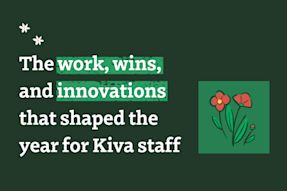Kiva and Financial Access Institute (FAI), a consortium of leading development economists focused on substantially expanding access to quality financial services for low-income individuals, have partnered to bring you a three week educational series on the different facets of microfinance. We will explore the differences between microcredit, microsavings, and microinsurance, in hopes of giving you, our community, a better depth of understanding of the sometimes complicated world of microfinance.
Let’s start with a basic introduction to microcredit. If you’ve ever wondered what the difference is between microfinance and microcredit then rest assured – you’re not alone. The terms are commonly (and mistakenly) substituted for one another in everyday use, but they actually mean different things.
What is the difference between microcredit and microfinance?
Microfinance refers to all kinds of financial services that can help low income people better manage their lives and their money, and includes microinsurance, microsavings and microcredit, which involves giving small loans to low income individuals for a range of purposes. So, you can think of microcredit as a narrower subset of microfinance.
How much microcredit is lent around the world?
By some estimates, at the end of 2020, as many as 140.3 million people had been given loans from microfinance institutions (MFIs) around the world. According to GCA Foundation’s Impact Finance Barometer, this amounts to an average annual growth rate of 2.0 percent since the previous year 2019. However, MFIs are not the only providers of microcredit. Moneylenders, savings clubs, and even families are common sources of credit for low income individuals, and microcredit comes in an array of sizes, costs (as measured by interest rate on a loan) and repayment timelines (the time it takes for a borrower to fully repay a loan).
How microcredit is used
Microcredit refers mostly to providing microloans to low income individuals and households (those that live on US $2 per day or less) for basic needs, or to individuals that might need capital to build small businesses (microenterprises). Their access to formal capital (from places like banks or even development finance institutions) may be restricted because they:
lack collateral and/or a credit history,
are unemployed or have low and uncertain sources of income, and
are seen as a credit risk by more conventional lenders of capital.
Microcredit has come to be seen as an important tool in the fight against poverty because when it works like it’s supposed to, it helps poor households make purchases they might otherwise have been unable to finance, like starting or expanding a business. This can allow low income individuals to be more productive and can sometimes set households on the path out of poverty.
Studies have also shown that many borrowers don’t use microloans solely for business purposes. In the book Portfolios of the Poor, the authors profiled low income households in South Africa, Bangladesh and India over the course of a year. They found that microcredit was sometimes being used to deal with “the triple whammy of poverty” – irregular, unpredictable and small incomes, and a lack of access to financial products to manage what money they do have. Households valued credit products that:
allowed them to finance important life events and emergencies
served as a means of enforcing savings discipline
allowed them to smooth consumption and meet daily expenditure needs at times when earnings were lean.
At FAI, we think that by helping low income individuals manage their money and better cope with poverty, this use of microcredit is just as valuable as the original credit-for-enterprise approach.
Kiva and microcredit
Kiva works with microfinance institutions all over the world to help provide microcredit to their clients. To learn more about how microcredit works within our model, check out Microfinance 101. Learn more in our articles on microsavings and microinsurance.















